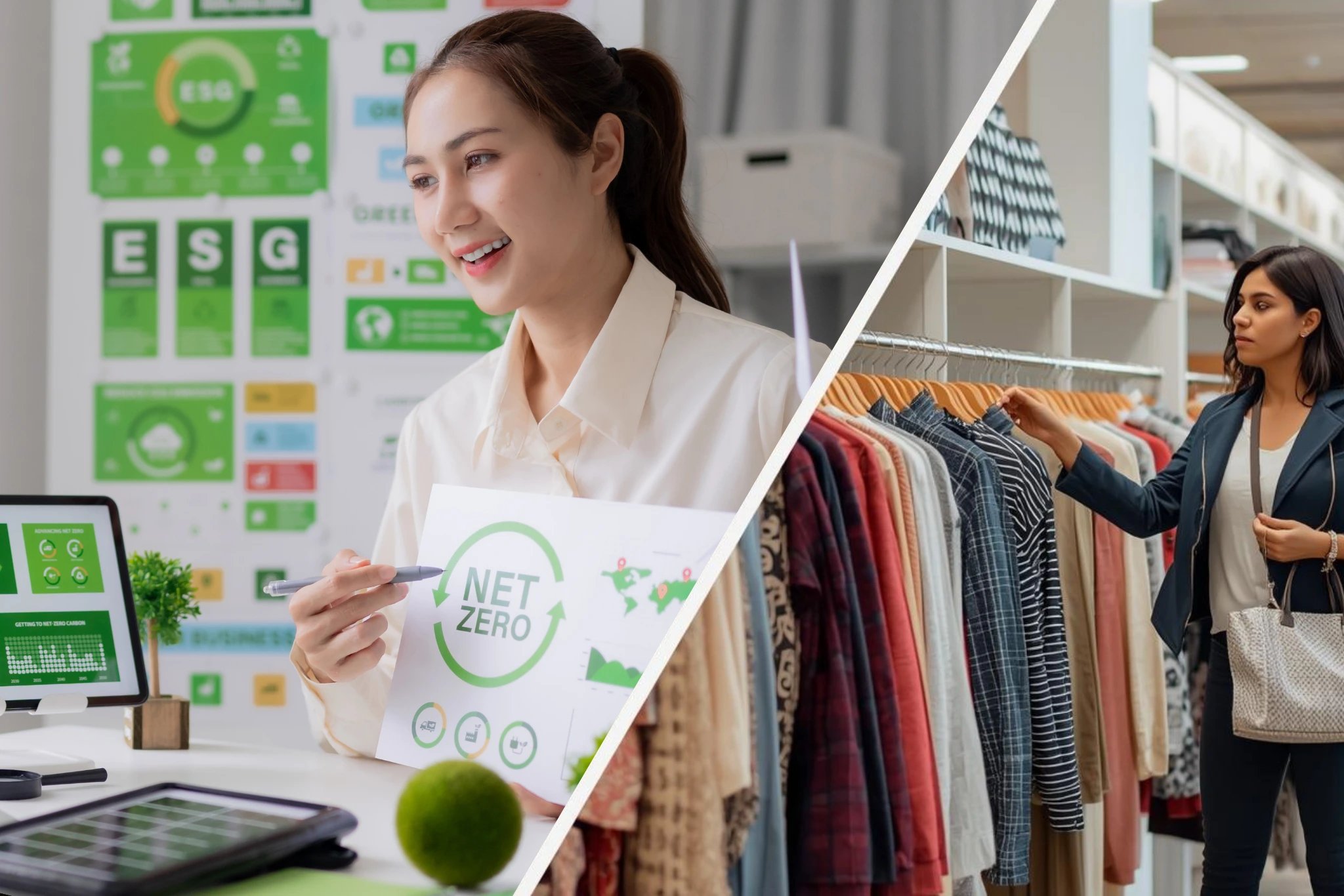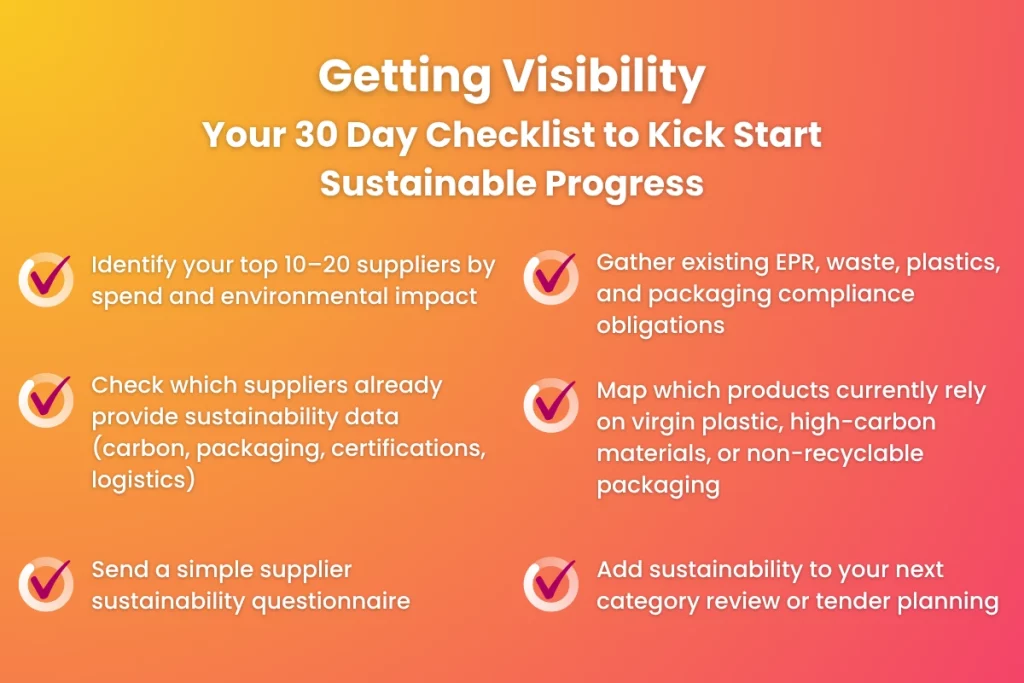
Turning bold sustainability promises into real results through procurement
Key Takeaway: Retailers don’t miss their climate goals because of a lack of ambition, they miss them because suppliers, buyers and budgets aren’t always organised to deliver on these goals. But once procurement teams have visibility on data, the right tools and the right partners in place, then sustainability becomes something that can be properly measured, correctly reported and even celebrated.
Retailers across fashion, food and beverage, consumer goods and electronics are publishing bold sustainability statements and commitments such as net-zero supply chains, 100% recyclable packaging and circular economy products.
In practice? Many targets stall, get pushed back, or vanish quietly from public reporting.
The truth is that most sustainability pledges are created in the boardroom and not where it needs to be which is where procurement teams operate – the supply chain. Sustainability teams make the commitments, but it’s buyers who source the products and negotiate the contracts. If these aren’t aligned then there is no real road map to achieving these very public goals.
Scope 3 emissions dominate retail carbon footprints. McKinsey (2022)1 notes that over 80% of the environmental impact of consumer products comes from the upstream value chain: ingredients, raw materials, manufacturing, packaging, and logistics.
Meanwhile, Reuters (2025)2 and Harvard Business Review (2022–2024)3 have documented a number of missed climate milestones, retracted claims, and “backpedalling” on Scope 3 targets as companies miss their goals due to cost pressures and supply complexity.
If sustainability depends on suppliers, but suppliers can’t or won’t make the necessary changes, targets will be missed, and very publicly at that.
Packaging Europe (2025)4 published a review on some of the big brands such as Unilever, PepsiCo, Mars, Coca-Cola, and L’Oréal that shows they have all either missed their sustainability targets entirely or had to scale back on their ambitions. These are perfect examples of the widespread disconnect between ESG and procurement teams – these are multi-million pound companies who have the resources to make it happen, but yet don’t.
So, in this practical procurement playbook for retailers we look at how to translate sustainability targets into real-world supplier contracts.
1. Sustainability lives in a PowerPoint deck. Procurement lives in contracts
While retailers announce ambitious net-zero or circular-packaging targets, buyers are still evaluating suppliers on cost, margin, speed to supply, and product availability. Sustainability usually sits behind these other seemingly more important attributes from a procurement perspective. Procurement teams are measured on cutting supplier costs and increasing margins and not necessarily working with them to supply more sustainable product options. ISO 20400 (the international standard for sustainable procurement) explicitly warns against the focus on cost over sustainability.
2. Scope 3 complexity and poor data
To reduce emissions, retailers need to know and measure where those emissions come from. But Scope 3 data sits with suppliers, many of whom can’t measure emissions accurately.
The Boston Consulting Group (2024) “Scoping Out”5 report found:
Most suppliers operate on thin margins and prioritise survival over long-term climate commitments.
3. Conflicted priorities inside the business
A sustainability team might promise “100% recycled packaging by 2027,” but a procurement manager facing scarcity of supply on plastic with recycled content may be forced to opt for readily available cheaper virgin plastic, protecting deadlines as well as margins. A definite win for the procurement team, not so much for the ESG team.
Without shared accountability, sustainability targets are disconnected from the day to day procurement decisions.
4. Standards and regulatory confusion
Procurement teams face a maze of frameworks, packaging, EPR laws and national recycling mandates. Some buyers aren’t aware of these new changes and how they will affect their sourcing procedures.
5. Long-term promises, but a lack of short-term plans
Retailers often set 2030 - 2040 goals but neglect immediate actions, the critical milestones and roadmap that plots the way to achieving these long term goals. This could include focus and direction on which suppliers will change, which materials will be switched, what reporting will be required?
Harvard Business Review (2022)6 concluded that many corporate climate plans represent “ambition without operational pathways.” Aspirations without roadmaps are easy to announce and just as easy to miss.
Now for the good news: The fix
Companies that succeed at sustainable procurement approach things differently for their communication, structure, governance and alignment.
1. Translate corporate targets into procurement KPIs
Create specific product targets: e.g., sustainable cotton, FSC packaging, recycled plastic content
Buyer scorecards are then linked directly to sustainability
2. Build partnerships between procurement and sustainability
The most successful retailers create joint decision-making between sustainability, procurement, finance, and operations teams.
This overcomes the “sustainability versus margin” challenge
3. Measure what you can today
Retailers often wait for perfect data which can stop progress
Make a start with simple supplier questionnaires
Set a 12 to 24 month plan to improve supplier data quality
4. Help suppliers to make the necessary changes you need
Many suppliers know how to reduce emissions but may be unable to make the investment to make it happen
Retailers that co-invest create stronger partnerships and often secure better pricing later
5. Put it in supplier contracts
Procurement has many levers at its disposal such as:
Setting up preferred supplier status for low-carbon operations
Creating new packaging briefs requiring recycled content or to be designed with ease-of-recycling in mind (the essence of EPR)
6. Be brave and publish
Companies that report publicly have more pressure to deliver. Reuters (2025)7 highlights that public transparency reduces greenwashing risks and forces internal partnerships to deliver on promises.
Getting visibility - 30 Day procurement checklist to kick start sustainable progress

As we have seen, sustainability pledges and supply chain need to align.
When procurement owns the sustainability conversation with KPIs in place, terms built into contracts, data and financing, that’s when retailers can make real progress.
If you are a procurement leader, there are simple steps you can take to kick-start your journey to stronger sustainability outcomes:
To get started and to find out more about how your suppliers can help you reach your sustainability goals click here
References